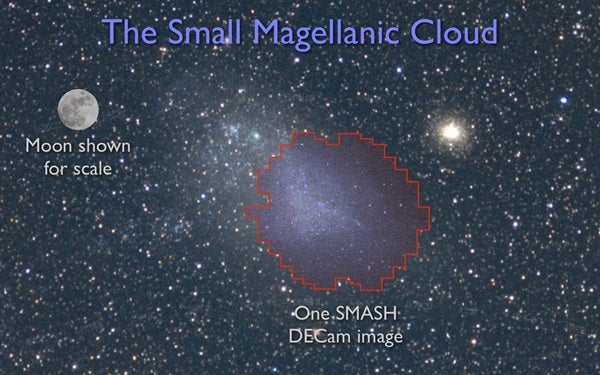The Large and Small Magellanic Clouds are dominant features in the Southern Hemisphere sky. Although named after explorer Ferdinand Magellan, who brought them to the attention of Europeans, they were already known to every early culture in the Southern Hemisphere. The Large Magellanic Cloud (LMC), covering about 5° in angular size (10 lunar diameters), appears to the naked eye like a detached piece of the Milky Way. At a distance from us of about 160,000 light-years, even the brightest stars in these galaxies can’t be seen without a telescope.
“We have a decent understanding of how large galaxies like the Milky Way form, but most galaxies in the universe are faint, distant dwarf galaxies,” said Principal Investigator David Nidever of the University of Michigan. “The Magellanic Clouds are two of the few nearby dwarf galaxies, and SMASH is able to map out and study the structures in them like no other survey has been able to do before.”
“We knew from the earlier work of SMASH team members that the LMC was larger than we thought, but those observations probed only 1 percent of the area that we need to explore,” said Knut Olsen of the National Optical Astronomy Observatory and one of the leaders of the SMASH team. “SMASH is probing an area 20 times larger, and is confirming beyond doubt that the LMC is really large while also giving us a chance to map its structure in detail.
The team has identified stars belonging to the LMC at angular distances up to 20° away, corresponding to 55,000 light-years. This was done using a new camera, dubbed DECam, mounted on the CTIO 4-meter Blanco Telescope, which allows the SMASH team to identify faint stars over a much larger area than ever before.
With the Blanco Telescope, SMASH can detect exceptionally diffuse stellar structures — up to 400,000 times fainter than the appearance of the faint band of the Milky Way in the night sky. This is possible because DECam can distinguish individual faint Magellanic stars over a huge area. (In astronomical parlance, the survey can reach a surface brightness limit of about 35 magnitudes per square arcsecond.) That allows the team to detect stellar structures that were previously much too faint to see.
The team is also exploring the Magellanic Stream, a gaseous structure that connects the two clouds and extends in front and behind them. The existence of the Magellanic Stream, first detected with radio telescopes more than 30 years ago, clearly indicates that the two galaxies are interacting with each other and with our Milky Way. Astronomers have long expected to also find stars in the stream, but so far none have been detected. It’s likely this is because the stellar component of the stream is too faint to have been detected until the availability of the new camera. As Nidever said, “SMASH’s ability to reveal super-faint stellar structures should not only allow us to finally detect the stellar component of the Magellanic Stream but also map out its structure, which will give us a much better understanding of the Magellanic Clouds’ interaction history.”










